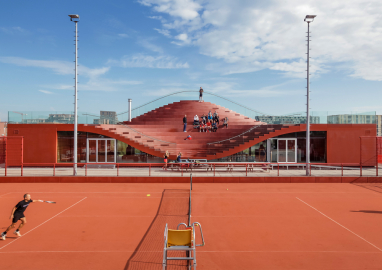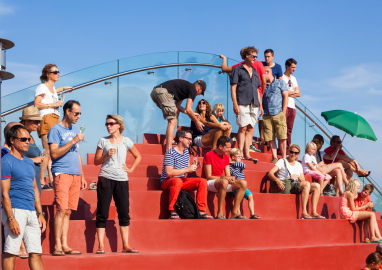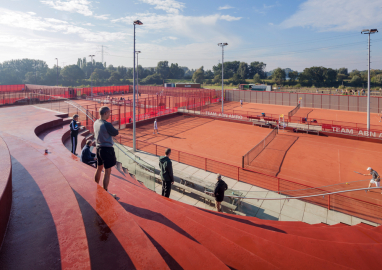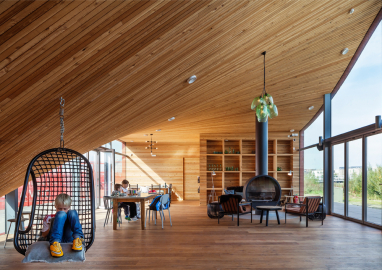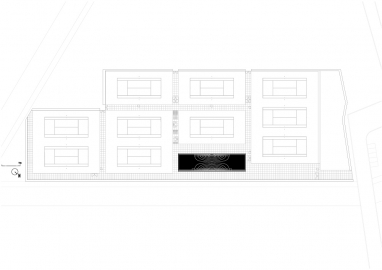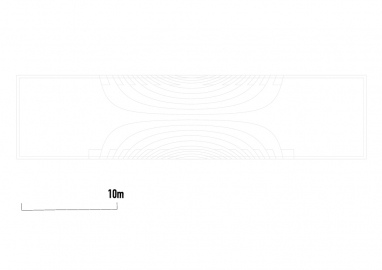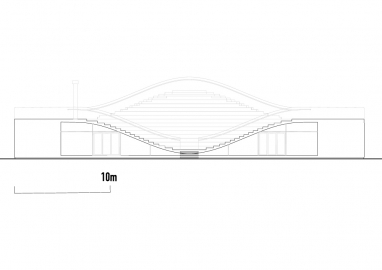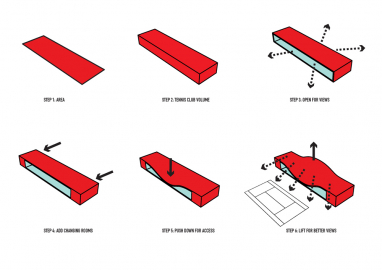Tennisclub IJburg
The new club house for TC IJburg combines the clubhouse typology with that of a sports tribune or grandstand, perfectly angled for centre-court viewing. The roof folds up to form this informal spectator platform, which can seat up to 200 people. The aim of the club is to be as accessible as possible, not a private club but a meeting place for young and old.
IJburg is a new district to the east of Amsterdam. On its six artificial islands, 18,000 homes will be eventually be built for 45,000 residents. At present, the district holds just 16,000 of these inhabitants. There are many initiatives to attract people to the area, such as the beach at Blijburg aan Zee, and the newly formed IJburg Tennis Club itself. The tennis club, currently with 1100 members, has 10 clay courts and a tennis school. The new club house is the centre of the club’s activities. The zoning for the area allowed space for a tennis club, but a building could not be built quickly enough, and so the courts were made and a temporary facility installed. The design is an attempt to minimise the use of valuable playing space by combining the clubhouse typology, a long low strip opened up to views of the courts on one side and the waters of the IJMeer on the other with that of a tribune.
The client’s brief asked for a design which could fill the vacant, elongated strip of land with an iconically functional building which provides both a viewing platform and a club overlooking the water. The club is open to the public, free of charge, 365 days a year, a meeting place for young and old, where you can grab a coffee and a healthy snack, or meet with friends, or even just check your emails. The challenge was to create a building that works as a central gathering for the area. A living room for IJburg, where the building becomes a part of the community like piece of street furniture. The design solution lay in combining the clubhouse typology with that of a sports tribune or grandstand. The club house is a long open volume with services on either side such as dressing rooms, a kitchen, storage and toilets. The main space is multifunctional, so it can be used for the club’s many events. The roof dips down towards the south side and is raised towards the north up to a height of 7m, creating an informal tribune for the club which can seat up to 200 people. The wide glass front to the north side allows extensive natural lighting and provides a view out over the waters of the IJ-lake.
An enormous challenge was to plan and construct the double curved concrete shell which functions simultaneously as a roof and a seating tribune. The structure would need to anticipate large dynamic loads and possible vibrations and distortions. As a solution, the concrete was cast in-situ in four parts; the two ends of the clubhouse which house the services and kitchen, as well as the steel mullions of the glass façade support the weight of the roof. Inside the club house, the concrete structure is clad with FSC-certified wood, with the outside fully sealed with an EPDM polymer hotspray in the same colour and texture as the clay tennis courts. The spray makes the building watertight and provides and anti-slip surface. The reduced glass surface to the south helps to cool the building. The thermal mass characteristics of the materialisation in concrete and wood are used to reach a high degree of energy efficiency. The building is heated by district heating made efficient by a heat exchange system. In summer it is naturally ventilated, adding to the ambitious sustainability profile of the structure.

